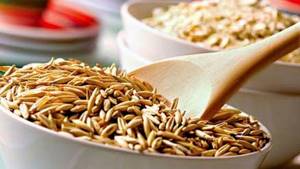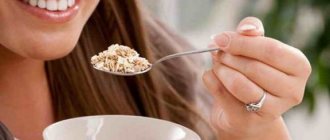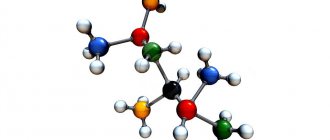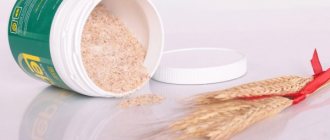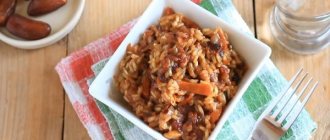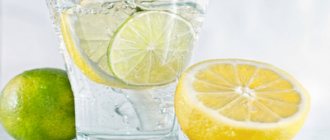Benefits of bran
The reason for the high biological value of bran is the germ layer, which contains vitamins and minerals.
The insoluble fiber included in the composition is resistant to the action of digestive juices and enzymes. When exposed to moisture, it swells and increases volume. It passes unchanged through the gastrointestinal tract and does not create a load on the glands.
The benefit of bran is the rapid onset of a feeling of satiety. You manage to eat less of other foods, which is useful for losing weight. Promote the development of beneficial microflora in the large intestine.
Insoluble plant fibers mechanically bind waste, promote the formation of feces, and stimulate intestinal motility.
Plant fiber slows down the absorption of carbohydrates, which prevents an increase in blood sugar, binds cholesterol, and normalizes increased levels of estrogen - one of the causes of female tumors and breasts.
Wheat bran is especially beneficial for the female body.
The predominance of refined foods in the diet, which contain little bran, is a common cause of constipation and irregular bowel movements. Plant fibers reduce the risk of colitis and hemorrhoids.
Insoluble fiber is a complex carbohydrate that does not increase blood glucose levels and reduces the risk of type 2 diabetes.
The varied mineral and vitamin composition is especially useful for those who are obese or overweight.
Excess weight is associated with metabolic syndrome, which includes hypertension, increased blood glucose levels, fat deposits around the waist, and elevated cholesterol levels.
Signs of metabolic syndrome are associated with the composition of the intestinal microflora, which depends on the inclusion of fiber in the diet.
Eating foods low in insoluble fiber changes the composition of the intestinal microflora. Microorganisms damage the epithelial cells of the intestinal walls, and inflammation develops. Therefore, a lack of bran contributes to the development of metabolic syndrome.
Study confirms the benefits of whole grains without removing the bran on weight loss and obesity in middle-aged women.
The study confirms that including enough dietary fiber in the diet reduces the risk of cardiovascular disease and mortality from respiratory diseases.
Research and research have linked eating whole grains and reducing the risk of coronary heart disease (CHD).
The study suggests a link between moderate consumption of plant fiber and a reduced risk of cardiovascular disease.
The benefits of bran are the formation of short-chain fatty acids in the colon, which reduces the risk of cancer, and they have a protective effect.
Contraindications
Despite all the usefulness of bran, their use still requires some caution. They have a powerful effect on the organs and, if eaten incorrectly and in the presence of certain diseases, can cause harm.
Contraindications for their use:
- exacerbation of ulcers, gastritis, colitis, pancreatitis, cholecystitis;
- adhesions in the abdominal cavity;
- allergy to cereals;
- hypotension.
Before organizing weight loss, it is advisable to undergo examination and consult with specialists. They can dispel your doubts and adjust the dosage and regimen.
Types and composition of bran
Oatmeal _ This variety is rich in the following substances (here and below the percentage of the daily value per 100 g of product is indicated).
Calorie content – 246 kcal.
Proteins – 17g (23%), fats – 7g (12%), carbohydrates – 51g (23%).
Dietary fiber – 15.4g (77%).
B vitamins: B1 – 78%, B5 – 29%, B9 – 13%, B2 – 12%, B6 – 8%, B4 – 6%, B3 –5%.
Vitamin B1 is necessary for the health of the heart, blood vessels, and gastrointestinal tract. B5 is involved in cholesterol metabolism and is essential for skin health. B9 is necessary for the processes of synthesis and cell division.
Vitamin E – 6.7%, K – 2.7%.
Macroelements: phosphorus – 92%, magnesium – 59%, potassium – 23%, calcium – 5.8%.
Phosphorus is involved in metabolic processes and is necessary for bones and teeth. Potassium is involved in the regulation of cellular balance and is necessary for the regulation of blood pressure. Magnesium maintains homeostasis of calcium, potassium and sodium; deficiency increases the risk of hypertension.
Microelements: manganese – 281%, selenium – 82%, copper – 40%, iron – 30%, zinc – 26%.
Manganese is necessary for the processes of growth and fat metabolism, metabolism, and is involved in the synthesis of cholesterol. Selenium is an antioxidant and has an immunomodulatory effect. Iron is necessary for redox reactions; a deficiency leads to anemia and atrophic gastritis. Copper is necessary for the absorption of protein and carbohydrates. Zinc is involved in the processes of synthesis and breakdown of carbohydrates, proteins, fats, and is part of 300 enzymes.
Essential amino acids: arginine, valine, histidine, isoleucine, leucine, lysine, methionine, threonine, tryptophan, phenylalanine.
Essential amino acids: alanine, aspartic acid, glycine, glutamic acid, proline, serine, tyrosine, cysteine.
Saturated fatty acids: lauric, myristic, palmitic, stearic.
Monounsaturated fatty acids (14%): palmitoleic, oleic (Omega-9).
Polyunsaturated fatty acids (24%): linoleic, linolenic.
Omega-3 – 13%, Omega-6 – 56%.
The study confirms that the polyphenolic compounds in oat bran are beneficial in preventing the oxidation of bad cholesterol, which reduces the risk of cardiovascular disease, and also has anti-inflammatory and antipruritic effects.
Wheat . Bran - the hard fibers of the outer layers of the grain, contains cellulose and beta-glucan, which helps normalize blood pressure.
Calorie content – 165kcal.
Proteins – 16g (21%), fats – 3.8g (6.8%), carbohydrates – 16.6g (7.6%).
Dietary fiber – 43.6g (218%).
B vitamins: B3 – 67%, B6 – 65%, B1 – 50%, B5 – 43%, B9 – 19%, B4 – 14.9%, B2 – 14.4%.
Vitamin E – 69%, K – 1.6%.
Macroelements: phosphorus – 118%, magnesium – 112%, potassium – 50%, calcium – 15%.
Microelements: manganese – 575%, selenium – 141%, copper – 99%, iron – 77%, zinc – 60%.
Omega-3 – 18.6%, Omega-6 – 43.5%.
Compared to other bran, moderate consumption of the wheat variety is most beneficial for health, improves well-being, and reduces bloating.
The article also confirms the benefits of wheat bran for gastrointestinal health.
The prebiotics included in the composition selectively stimulate one or more populations of beneficial bacteria in the colon, which improves its condition.
Research supports the benefits of wheat bran and plant fibers in reducing estrogen levels, which in turn may be associated with a reduced risk of breast cancer.
This healthy product goes well with cereals, milk, and fermented milk products.
Wheat bran is taken with honey for respiratory diseases.
Corn bran.
Calorie content – 224 kcal.
Proteins – 8.36g (11%), fats – 0.9g (1.6%), carbohydrates – 6.64g (3%).
Dietary fiber – 79g (395%).
B vitamins: B3 – 13.7%, B5 – 12.7%, B6 – 7.6%, B2 – 5.6%, B4 – 3.6%, B9 – 1%, B1 – 0.7%.
Vitamin E – 2.8%, K – 0.3%.
Macroelements: magnesium – 16%, phosphorus – 9%, calcium – 4.2%, potassium – 1.8%,
Microelements: selenium – 30%, copper – 24%, iron – 15.5%, zinc – 13%, manganese – 7%.
Saturated fatty acids: palmitic, stearic.
Monounsaturated fatty acids (1.4%): palmitoleic, oleic (Omega-9).
Polyunsaturated fatty acids (3.8%): linoleic, linolenic.
Omega-3 – 1.4%, Omega-6 – 8.7%.
The benefit of corn bran is its ability to bind carcinogens dinitropyrene and heterocyclic amines, which are formed when frying fish or meat. It is important to use domestic corn rather than genetically modified corn.
Rice bran is as effective as oat bran, reducing cholesterol levels by more than 25%. The shell, which gives the grains a brown tint, and the germ layer contain a lot of nutrients.
Calorie content – 316 kcal.
Proteins – 13.3g (17.6%), fats – 20.8g (37.2%), carbohydrates – 28.7g (13.1%).
Dietary fiber – 21g (105%).
B vitamins: B6 – 203%, B1 – 183%, B3 – 170%, B5 – 147%, B2 – 15%, B9 – 15%, B4 – 6.4%, B15 (pangamic acid).
Vitamin E – 32.8%, K – 1.6%.
Macroelements: phosphorus – 209%, magnesium – 195%, potassium – 59%, calcium – 5.7%.
Microelements: manganese – 710%, iron – 103%, copper – 72%, zinc – 50%, selenium – 28%,
Saturated fatty acids: lauric, myristic, palmitic, stearic.
Monounsaturated fatty acids (45%): palmitoleic, oleic (Omega-9).
Polyunsaturated fatty acids (66%): linoleic, linolenic.
Omega-3 – 35%, Omega-6 – 100%.
Rye . Bran decoction is useful for chronic tracheitis and bronchitis. It is used as an expectorant and emollient.
Recipe for accelerating the ripening of abscesses:
- Soak rye bread in hot milk and apply it to the abscess.
The study confirms that rye causes a low glycemic response in rats.
How to take bran
Bran consumption rate: 25g per day for young women, 38g for young men.
The need is increased during pregnancy and lactation – up to 28g per day.
After 50 years, the norm for women is 21g, for men – 30g.
Consuming more than 70g per day leads to negative consequences - bloating due to fermentation, cramps, gas formation, nausea, constipation or diarrhea.
Excess bran binds and removes trace elements calcium, magnesium, iron, and zinc from the body.
It is better to consume this healthy product in steamed form, so as not to injure the walls of the small intestine. It is also added to porridges and soups.
Introduce insoluble fiber into the diet carefully, with 1 tsp. in a day. You can take a glass (brew 1 tsp with a glass of boiling water) before your morning jog or evening walk.
Since insoluble fiber absorbs moisture well and increases volume by 3-5 times, you need up to 2-3 liters of liquid per day. Otherwise, bran creates dense structures in the intestines.
As a rule, the cereal shell is taken finely ground, 2 tbsp. (10g) 15 minutes before meals, wash down with a glass of water.
Some people believe that grinding in a blender reduces the benefits of bran.
The study confirms that the difference in efficiency between conventionally and finely ground fibers is not significant. In addition, small particles cause less damage to the intestinal walls.
Which ones to choose
Criterias of choice:
- Where to buy - for weight loss, it is better to purchase bran at a pharmacy.
- Ingredients - without additional flavor enhancers, which only increase the calorie content of the product, which does not contribute to weight loss.
- Type of processing: crushed, not granulated.
- Peel thickness should be as thin as possible.
- Grinding - the finer, the more pleasant it is to use.
- The presence of husks - ideally, they should be absent, which indicates the purity of the product.
Stamps
- Di&Di

A wide range of. Almost all types of bran are produced; they are especially popular with additives - kelp and Jerusalem artichoke. The prices are reasonable and correspond to the quality of the product.
- Myllyn Paras (Finland)
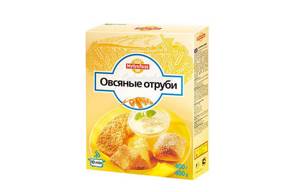
If we talk about quality, their peel is thick, the flour is not sifted. The grind is coarse rather than medium. But there is no husk and very low prices.
- Fazylbak

This is bran from sprouted oats from ecologically clean regions of the Caucasus. There is flour, the grind is fine - convenient for diluting in drinks. The price is average. The only negative is a lot of husk.
- Dr. Dias

There is a manufacturer on the market that offers several types of bran, but the packages contain regular grain. So it is better not to purchase this brand.
- SibTar

The peel is thick, there is flour, the grind is medium, there is no husk. The low price makes the product in demand on the market. If not for the large amount of flour, it could be called ideal.
- Eco-Hit. Premium
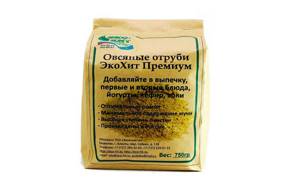
Flour and husks are present in small quantities. The grind is medium. The price is high. Some of the best on the market today.
Medicinal benefits of bran
Constipation.
Recipe 1:
- Grind oat bran to flour.
Take 1 tsp once a day with a glass of warm water.
Recipe 2:
- Steam the bran, pass through a meat grinder, add pitted prunes and raisins.
- Mix thoroughly and form into balls.
Eat in the morning, wash down with water.
Recipe 3:
- Pour 2 tablespoons of hot milk into a glass. wheat bran, leave in a sealed container for 40 minutes, wrapping it well.
In the morning, take 0.5 cups before breakfast.
Recipe 4:
- Grind wheat bran, brew with boiling water for half an hour, drain the water.
Add the gruel to any dish, first 1 tsp, after a week - 1 tsp, after another week - 2 tsp, three times a day.
This method is useful in cases of atherosclerosis and excess weight.
The article concluded that in the case of irritable bowel syndrome, increasing dietary fiber intake may be beneficial for constipation.
Research confirms the benefits of wheat bran. Daily consumption for 14 days improved bowel function and reduced constipation in healthy women who previously had insufficient fiber intake.
Diarrhea . A decoction of rye bran is beneficial for diarrhea, and also as an expectorant for coughs. A decoction of wheat bread crumb has a similar effect.
In combination with honey, bran decoction is also used to treat respiratory diseases and cough.
Expectorant. Folk recipe for bronchitis, colds, sore throat:
- Brew 400g of bran with a liter of boiling water, let cool, strain.
Take hot during the day, add burnt sugar for taste.
Restoration of strength , source of energy, additional nutrition for the sick, elderly, and weakened children:
- Brew 500 ml boiling water 1 tsp. wheat or rye bran, boil for 30 minutes.
- Add 1 tbsp. honey, boil a little more.
Take 50g per day warmly 3-4 times a day. Can be added to soup, porridge.
Raising immunity:
- Rinse 100g of whole wheat or rye grains, soak in water for 2-3 hours, dry on a napkin, and pass through a meat grinder.
- Add 1 tbsp. honey, 1 tbsp. either sour cream, cream, or milk.
Take before breakfast.
Hypertension. High blood pressure, atherosclerosis - prepare bran decoction:
- Brew 1 liter of boiling water with 200 g of wheat bran, boil for 15 minutes, strain.
Take 1/2 cup 3-4 times a day.
Diabetes. Lifestyle is important for the primary prevention of type 2 diabetes.
Study confirms that insoluble fiber and whole grains reduce the risk of developing type 2 diabetes.
Eating a diet that contains enough fiber can also help lower glucose levels in people with diabetes, although individual differences must be taken into account.
The article confirms that including bran and plant fiber in the diet reduces sugar levels in the case of type 2 diabetes. Therefore, they are useful, their moderate use is acceptable as a way to counteract the disease.
Brief summary
So, we came to the conclusion that oat and wheat bran have one main difference - the type of fiber. Based on this, the difference between bran lies in their effect on the body.
Functions of oatmeal:
- Reducing sugar and cholesterol levels;
- Colon cleansing (gentle);
- Boosting immunity.
Functions of wheat:
- Choleretic effect;
- Stimulation of peristalsis;
- Cleansing the intestines from pathogenic flora, toxins, etc.
When choosing the appropriate option, take into account the state of your own stomach, peristalsis and, of course, the main purpose of introducing the product into the diet. Remember a simple rule: less is more.
Bran for weight loss
Excess fat, a full colon and constipation put pressure on the veins in the groin and thighs. To look slimmer, some women wear clothes that hug their figure.
As a result, the vessels weaken, blood circulation in them worsens, and the pressure in the veins increases. Constant tension dilates blood vessels and varicose veins develop.
Insoluble fiber is good for the intestines and helps cope with constipation and excess weight.
Beans and rice bran contain pangamic acid (vitamin B15). This substance is not a vitamin, since its strict necessity in the diet has not been proven.
Pangamic acid improves the metabolism of fats and carbohydrates, the absorption of oxygen in tissues, and eliminates hypoxia, which is important for obesity and varicose veins.
With a strict diet for weight loss, the benefit of bran decoction is to eliminate the feeling of hunger, a source of strength:
- Brew 1 liter of boiling water for 200 g of grain shells, boil for 15 minutes, strain.
Take a glass during the day between meals. For taste, add a little honey or jam.
The study confirms that increasing your fiber intake alone and including plant-based foods in your diet is not enough for weight loss. An increase in physical activity is also necessary.
Research on fiber supplements for weight loss confirms that there is insufficient evidence of their ability to significantly reduce body weight, fat, and glucose levels.
Side effects
Eating bran does not always result in the expected weight loss. If contraindications, dosages and expert advice are not followed, side effects are possible that will require stopping the diet:
- gas formation;
- formation of fecal stones;
- when there is insufficient water, metabolic processes are disrupted;
- bloating;
- irritation of the intestinal walls;
- dehydration.
If your health has worsened and does not return to normal within 2-3 days (during this time the body should have adapted to the abundance of fiber), you should seek medical help.
External benefits of bran
Mask for dry skin:
- Stir 4 tbsp. warm infusion of kombucha, 3 tbsp. honey, 3 tbsp. wheat bran.
Apply to cleansed skin, rinse with warm water after half an hour.
Whitening hand mask:
- Dilute oat or wheat bran with hot milk to make a paste.
Apply to the back, after 20 minutes, rinse with warm water, wipe off, and apply cream.
Softening mask:
- Brew 1/2 cup of bran with a glass of boiling water and let cool.
Place the brushes in a warm mixture, after 10 minutes, rinse with warm water and dry.
Rinse for all hair types:
- Pour 500 ml of water into a glass of bran, boil, strain, add vodka:
- for oily hair – 10 tsp, for normal hair – 5 tsp, for dry hair – 1-2 tsp.
Rinse clean, washed hair.
Dry split ends, dandruff:
- Pour a glass of water over a glass of bran, bring to a boil over low heat, simmer for 2-3 minutes, let cool slightly.
- Add 1/3 glass of white wine, leave for 30 minutes in a dark place.
- Strain and squeeze out the mixture thoroughly.
Dilute with the same amount of water and rinse with clean, damp hair.
Dry hair:
- Grind rye bread with added bran, brew with boiling water, leave for 1-2 days.
Add the yolk of a chicken egg, wash your hair without shampoo.
A stricter bran diet
This option is for two days . Every day you need to consume 200 grams of crispy bran, washing it down with water or green tea and dividing it into five meals. After two days of such nutrition, you need to return to a balanced and moderate diet.
